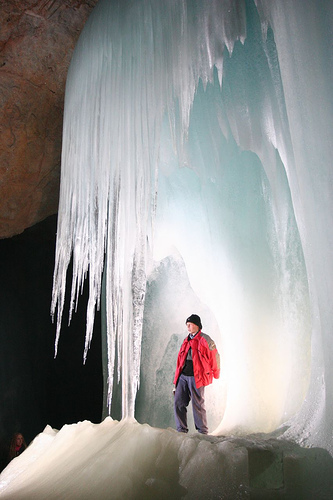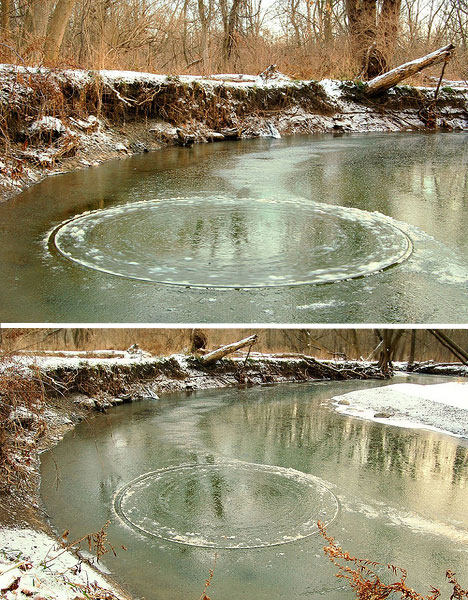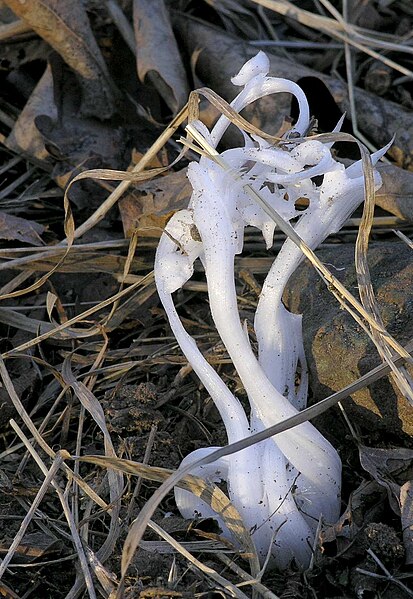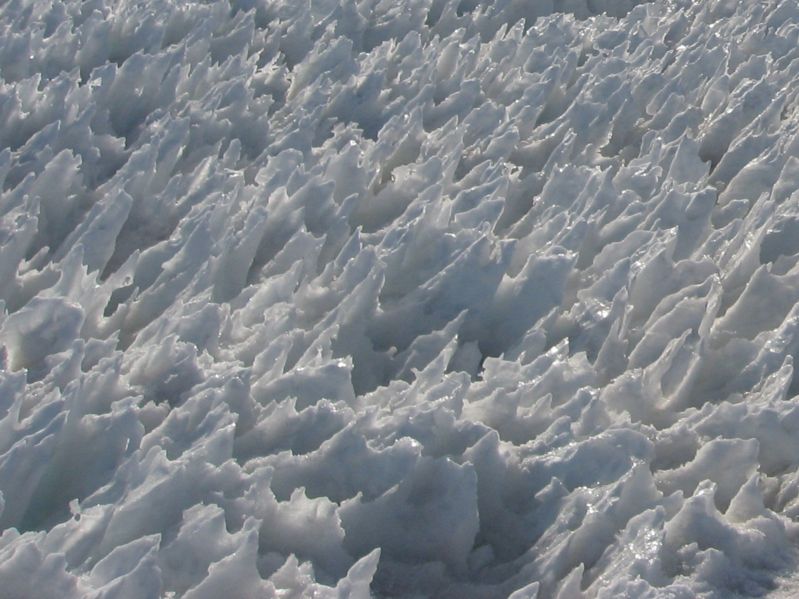Info: Frozen Wonders of Nature
1. Ice Spikes:


Penitentes are a snow formation found at high altitudes. They take the form of tall thin blades of hardened snow or ice closely spaced with the blades oriented towards the general direction of the sun. Penitentes can be as tall as a person.
Penitentes were first described in the literature by Darwin in 1839. On March 22, 1835, he had to squeeze his way through snowfields covered in penitentes near the Piuquenes Pass, on the way from Santiago de Chile to the Argentinian city of Mendoza, and reported the local belief (continuing to the present day) that they were formed by the strong winds of the Andes. These pinnacles of snow or ice grow over all glaciated and snow covered areas in the Dry Andes above 4,000 m (Lliboutry 1954a, Lliboutry 1954b, Lliboutry 1965). They range in size from a few cm to over five metres. (Lliboutry 1965, Naruse and Leiva 1997).
Lliboutry noted that the key climatic condition for the differential ablation that leads to the formation of penitentes is that dew point is always below freezing. Thus, snow will sublimate, which requires higher energy input than melting. Once the process of differential ablation starts, the surface geometry of the evolving penitente produces a positive feedback mechanism, and radiation is trapped by multiple reflections between the walls. The hollows become almost a black body for radiation, while decreased wind leads to air saturation, increasing dew point temperature and the onset of melting. In this way peaks, where mass loss is only due to sublimation, will remain, as well as the steep walls, which intercept only a minimum of solar radiation. In the troughs ablation is enhanced, leading to a downward growth of penitentes. A mathematical model of the process has been developed by Betterton (2001), although the physical processes at the initial stage of penitente growth, from granular snow to micropenitentes, still remain unclear. The effect of penitentes on the energy balance of the snow surface, and therefore their effect on snow melt and water resources have been described by Corripio (2003) and Corripio and Purves (2005).(Source)
2. Frozen Waterfalls:

The growth of a frozen waterfall can proceed only gradually, for progressive freezing of the flowing water. There are thousands of frozen falls around the world. The one located at Beijing's Myun County attracts tourists from all over the country as well as internationally. A beautiful display of nature's art at work.
3. Ice Cave:

The term ice cave refers to any type of natural cave (most commonly lava tubes or limestone caves) that contains significant amounts of perennial (year-round) ice. At least a portion of the cave must have a temperature below 0 °C (32 °F) all year round, and water must have traveled into the cave’s cold zone.
The term ice cave is often used to describe a cavity formed within ice, which is properly called a glacier cave.(Source)
4. Ice Shelves:

An ice shelf is a thick, floating platform of ice that forms where a glacier or ice sheet flows down to a coastline and onto the ocean surface. Ice shelves are found in Antarctica, Greenland and Canada only. The boundary between the floating ice shelf and the grounded (resting on bedrock) ice that feeds it is called the grounding line. When the grounding line retreats inland, water is added to the ocean and sea level rises.
In contrast, sea ice is formed on water, is much thinner, and forms throughout the Arctic Ocean. It also is found in the Southern Ocean around the continent of Antarctica.
Ice shelves flow by gravity-driven horizontal spreading on the ocean surface. That flow continually moves ice from the grounding line to the seaward front of the shelf. The primary mechanism of mass loss from ice shelves is iceberg calving, in which a chunk of ice breaks off from the seaward front of the shelf. Typically, a shelf front will extend forward for years or decades between major calving events. Snow accumulation on the upper surface and melting from the lower surface are also important to the mass balance of an ice shelf.
The thickness of modern-day ice shelves ranges from about 100 to 1000 meters. The density contrast between glacial ice, which is denser than normal ice, and liquid water means that only about 1/9 of the floating ice is above the ocean surface. The world's largest ice shelves are the Ross Ice Shelf and the Filchner-Ronne Ice Shelf in Antarctica.
The term captured ice shelf has been used for the ice over a subglacial lake, such as Lake Vostok.(Source)
5. Striped Icebergs:

Icebergs in the Antarctic area sometimes have stripes, formed by layers of snow that react to different conditions. Blue stripes are often created when a crevice in the ice sheet fills up with meltwater and freezes so quickly that no bubbles form. When an iceberg falls into the sea, a layer of salty seawater can freeze to the underside. If this is rich in algae, it can form a green stripe. Brown, black and yellow lines are caused by sediment, picked up when the ice sheet grinds downhill towards the sea
6. Frozen Tidal Wave:

Despite it looks, this is not really a tidal wave but ice created from glacial movements forming tidal wave looks.
7. Ice Circles:

An ice circle is a rare phenomenon that occurs in slow moving water in cold climates. It consists of large discs of ice that rotate slowly in the water. It is believed that they form in eddy currents. Ice circles have most frequently been observed in Scandinavia and North America, but one was recorded in Britain in January 2009.[1] A Met Office spokesman was described as "kind of a bit stumped to be honest".
Additionally the photo shows a collection of small ice circles (the largest about 12" (30cm) in diameter) seen on the river Llugwy at Betws-y-coed, North Wales, in December 2008. A fortnight of no rain had resulted in low water levels, and there had been sub-zero temperatures for a week.
Ice circles occur at bends in the river where the accelerating water creates a force called 'rotational shear', which breaks off a chunk of ice and twists it around. As the disc rotates, it grinds against surrounding ice — smoothing into a perfect circle.
Another kind of ice circle are actually ice pans, or surface slabs of ice that form in the center of a lake or creek, instead of along the water's edge. They can be explained by quick shifts in temperature. As water cools, it releases heat that turns the water into frazil ice — a collection of loose, needle-shaped ice particles that can cluster together in an ice pan. If a lake accumulates enough frazil ice and the current is slow, over time, the pan can become a hanging dam: a dense, heavy piece of ice with high ridges and a low center.(Source)
8. Glaciers:

.jpg)
.jpg)

A glacier is a large mass of ice moving slowly over some land surface or down a valley, formed over long periods from the accumulation of snow in areas where the amount of snow that falls exceeds the amount that melts. The word glacier comes from French via the Vulgar Latin glacia, and ultimately from Latin glacies meaning ice.
Glacier ice is the largest reservoir of fresh water on Earth, and second only to oceans as the largest reservoir of total water. Glaciers cover vast areas of the polar regions and are found in mountain ranges of every continent except Australia, as well as in New Zealand. In the tropics glaciers are restricted to the highest mountains. The processes and landforms caused by glaciers and related to them are referred to as glacial. The process of glacier growth and establishment is called glaciation. Glaciers are sensitive monitors of climate conditions and are crucial to both world water resources and sea level variation.(Source)
9. Snowflakes:

Snowflakes begin as snow crystals which develop when tiny supercooled cloud droplets (about 10 μm in diameter) freeze. Snowflakes come in a variety of sizes and shapes. Colder environments lead to column-like development of the flakes, while warmer temperatures lead to thin and flat crystal development. Complex shapes emerge as the flake moves through differing temperature and humidity regimes. Types which fall in the form of a ball due to melting and refreezing, rather than a flake, are known as graupel, with ice pellets and snow grains as examples of graupel. Snowflakes are used as a symbol for winter tires, and for the 2002 Winter Olympics.(Source)
10. Ice Flowers:

Ice flowers are formed on new layers of sea ice, from saturated water vapors that come up from under the ice through cracks. In contact with the cold air, the vapors start to freeze and the salt on the surface of the ice begins to crystallize and serves as a nucleus for the frozen vaporized water. Thus, molecule by molecule the ice flowers begin to take shape. They have recently been recognized as the dominant source of sea salt aerosol in Antarctica and scientist suspect they may be the main cause of tropospheric ozone depletion during the polar sunrise. One of the most beautiful frozen wonders on Earth, ice flowers are still a mystery to many people. (Source)
Subscribe to:
Post Comments (Atom)



0 comments:
Post a Comment